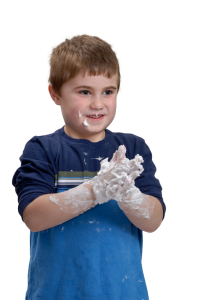Sensory Processing Disorder (SPD)
 The human body is comprised of a complex, intricate and amazing set of systems that all work in conjunction with one another. One of these systems, part of the nervous system, is the sensory system. This system is in charge of how our brain receives and processes information for our five senses, our balance and our sense of our movements. Our sensory system includes visual (sight), auditory (sound), tactile (touch), olfaction (smell), gustatory (taste), vestibular (balance and spatial orientation) and proprioception (one’s perception). There has been a preponderance of children whose sensory system is out of balance or out of sync and this is now referred to as sensory processing disorder or SPD.
The human body is comprised of a complex, intricate and amazing set of systems that all work in conjunction with one another. One of these systems, part of the nervous system, is the sensory system. This system is in charge of how our brain receives and processes information for our five senses, our balance and our sense of our movements. Our sensory system includes visual (sight), auditory (sound), tactile (touch), olfaction (smell), gustatory (taste), vestibular (balance and spatial orientation) and proprioception (one’s perception). There has been a preponderance of children whose sensory system is out of balance or out of sync and this is now referred to as sensory processing disorder or SPD.
SPD affects the way a person registers, interprets and processes information by the brain. It affects a great number of functions that most of us take for granted like how we see, hear, feel, smell, or taste things. When a person has SPD, they may react differently than we expect to sensory stimuli either with extreme aversion or strong appeal.
For instance, a child with very sensitive reactions will avoid lights, sounds, tags on clothing, smells or spicy foods while a child with inhibited senses will seek bright lights, loud sounds, heavy textures, strong smells and tastes. The issue of SPD is in the receiving and processing of sensory information allowing for very varied reactions to the senses.
When I first learned about SPD, I was only thinking of these five senses. I was understanding for the first time why my son could not handle any lights or sounds, did not want to eat food that had any taste and would not put his hands or feet into the sandbox. However, as I learned more, I realized that SPD also involved his sense of balance, posture, spatial orientation and his sense of where he was in space in relation to where others or things were in space.
Focusing on assisting a child who has issues with their five senses is an extraordinary feat and requires support from experts such as; occupational, physical and speech therapists. Depending upon age, it may involve help from Early Intervention (EI), which is a government-funded group who provides at home support to families in each of these areas for a child under the age of three. If your child is over the age of three, you need to find your own support through local clinicians.
Navigating the labyrinth of issues when you are unaware of the range of issues is not easy, especially as most of us as parents are not well versed in child development.
I remember being perplexed by discussions of the vestibular and proprioception systems. I remember not having a clue to what therapists were talking about regarding my son. The term SPD was not discussed or pursued and there was no layman’s terminology to explain this to a non-child development knowledgeable parent.
So, I think each of us can relate to the five familiar senses of sight, sound, touch, smell and taste, but let’s explore those other two – the vestibular and the proprioception.
The vestibular system is in charge of telling us where we are and what we are doing, so it’s more than just a sense of balance due to our inner ear. It lets our eyes and our brains know when we are moving versus when something else is moving. So, essentially, it’s our internal compass.
The proprioception system is our body’s ability to sense its orientation in space without having our eyes confirm it.
So if these two senses are out of whack, a child does not know how to move his body or where it is in space. The result is a child who is hesitant to engage in physical activity, especially with lots of other children, OR who seeks tremendous amount of input. And it’s a child who bumps into things and others – a lot.
I remember my son would continually crash into his sister when the poor thing was just learning how to walk. She would toddle along with her shoulders hunched up as her brother approached, knowing full well, that he would crash right into her. She knew how she was moving and could sense him in space, but he cannot reciprocate. Crash and down they would go. Luckily, she was sturdy and resilient and he was open to learning how to navigate his world better. So, even though, he did it again and again – we worked through it. Now they both can navigate their worlds freely without fear of crashing into each other.
Sensory Processing Disorder (SPD) is getting easier to ‘diagnose’ and there is much more familiarity around it now than even 10 years ago. If you have an inkling that your child has an issue with his or her senses, explore it further and follow your instincts. Getting help early is the best, but getting help anytime is better than hoping it will work itself out. There are so many successful strategies that are easy to do and will help the child immensely. Giving your child these strategies will either prevent or mitigate the impact on his or her development. If not addressed, the result can be unusual ways of responding or behaving, finding things harder to do. Difficulties may typically present as difficulties planning and organizing, problems with doing the activities of everyday life (self care, work and leisure activities), and for some with extreme sensitivity, sensory input may result in extreme avoidance of activities, agitation, distress, fear or confusion.
If addressed, your child has strategies to work through his or her issues, he or she gains confidence and stamina to work through difficulties and also learns to seek assistance when required.
One of the best resources is the Out of Sync Child by Carol Kranowitz. Her book is available at Barnes & Noble or Amazon and her website is: www.out-of-sync-child.com.


This really sparks my curiosity, Kim. Thank you! I am interested to learn more about how exactly SPD translates into difficulty planning & organizing and difficulty with everyday chores. Is this why I don’t like doing dishes? 🙂
I will be getting into the trajectory of SPD & executive functioning (planning, etc.) in the new year. But, regardless, I totally agree re: dishes!
I still cut the tags out of my clothes 🙂
I love it! LOL.